Lubomir Kavalek
Chess Robots By The Sea
The Huffington Post, January 24, 2011Are chess players becoming robots by repeating moves approved at home by their computers?
Can't they just use their own heads during the game?
Of course they do, but at the same time even the world's top chess players have to use computers to win chess games. Not during the games - that's forbidden - but in their preparations. And they don't even have to be there. The computers can find a winning solution while the players eat at a nearby restaurant. They come home, apply the knowledge to the game, perform the moves like robot and claim victory. The times are gone when the legendary grandmaster David Bronstein would think 40 minutes before he made the first move. Now the players blitz away 30 moves, only replaying the computer recommendations. During the year's first major tournament, underway in the coastal Dutch town of Wijk aan Zee, some of the robotic skills were evident. Even the world champion Vishy Anand of India successfully retrieved a two-year-old knight sacrifice from his machine and won a nice game.
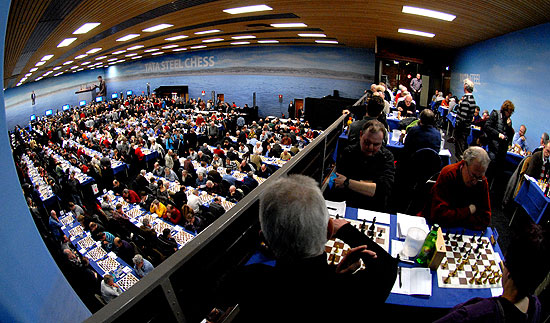
The traditional chess festival grew from a local club event in 1938 to a hugely popular chess festival where hundreds of amateurs can mingle with the world's best players and can get the first cold or flu of the year. The stars - Anand, Magnus Carlsen of Norway, Levon Aronian of Armenia and Vladimir Kramnik of Russia - were natural contenders for the first prize in the grandmaster group A. Carlsen slipped in the third round and lost to Amish Giri. It was the top American Hikaru Nakamura who took the sole lead after seven rounds with 5,5 points. In his next game, Nakamura lost to Carlsen. And the standings are jammed as follows: Anand and Nakamura 5,5 points out of eight games; Aronian,Carlsen, Kramnik and the Frenchman Maxime Vachier-Lagrave 5 points. The last five rounds promise a dramatic finish. It can be followed on the official web site.
Displaying a natural tactical talent, Carlsen was often compared to Mikhail Tal at the beginning of his career. In his book Heroes of Classical Chess, published by Everyman Chess, Craig Pritchett puts him in the same league with Akiba Rubinstein and the world champions Bobby Fischer, Vassily Smyslov and Anand. In the book Champions of the New Millenium, published by Quality Chess, Carlsen was called the improved Capablanca for his deep endgame understanding and excellent ability to calculate.
His victory against Nakamura in Wijk aan Zee is an attacking masterpiece, well suited to be included in the future editions of Jacob Aagard's excellent treaties of Attacking Manuals. The two volumes published by Quality Chess are a joy to read. The game shows the difference between attacking the enemy king with the pawns or with the light pieces. In both cases you need to weaken the king's shelter. Carlsen's pawn storm succeeded, Nakamura failed to dent white's defense. It was the Najdorf Sicilian and we pick it up after 26 moves.
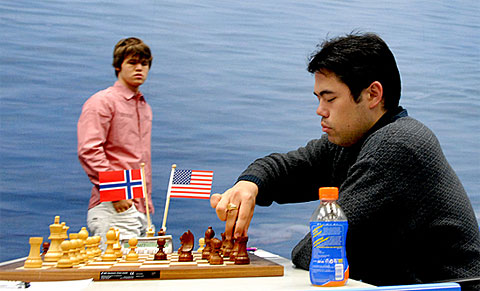
Carlsen - Nakamura
Wijk aan Zee 2011
Grandmaster Group A, Round 8

27.Nd5!
(Showtime! Carlsen lets his pieces loose.)
27...Bxd5
(Nakamura decides to eliminate one attacking piece. Leaving the knight on the board leads to a cascade of beautiful sacrifices, for example after 27...Rc4 white can conclude the game sacrificing both rooks and a bishop: 28.Rxh6! gxh6 29.Rxf8+! Rxf8 [Or 29...Kxf8 30.Bxh6+ Kg8 31.Nf6+ Kh8 32.g7 mate.] 30.Ne7+ Kg7 31.Bxh6+! Kxh6 [Or 31...Kh8 32.g7+ Kh7 33.gxf8N+ Kxh6 34.Ndf5+ Bxf5 35.Nxf5+ Kh5 36.Qh4 mate.] 32.Qh4+ Kg7 33.Nxe6 mate.)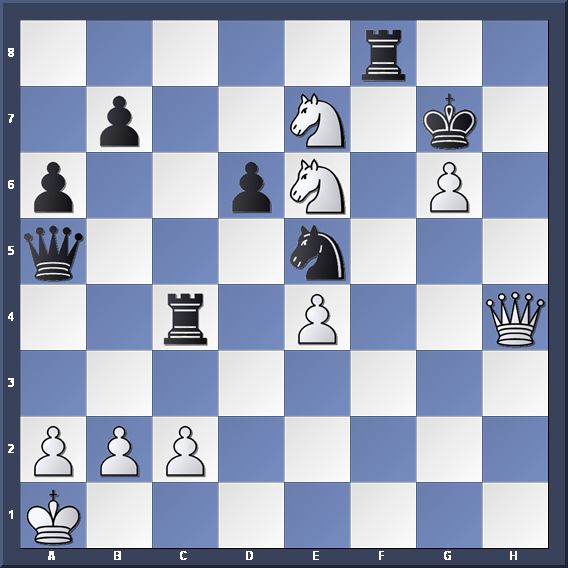
28.exd5 Qxd5
(The pawn is irrelevant, but Nakamura is making sure the white knight doesn't land on the square e6. For example, after 28...Rc4 29.Ne6 Ra4 30.a3 Rg4 31.Qf2 Rxg6 32.Rh5 Qxd5 33.Rxe5! Qxe5 34.Qf7+ Kh7 35.Nxf8+ Rxf8 36.Qxf8 white should win;
Or after 28...Qb4 29.c3 Qc4 30.Bxh6! wins.)
29.Bxh6! (Unlocking the h-file.)
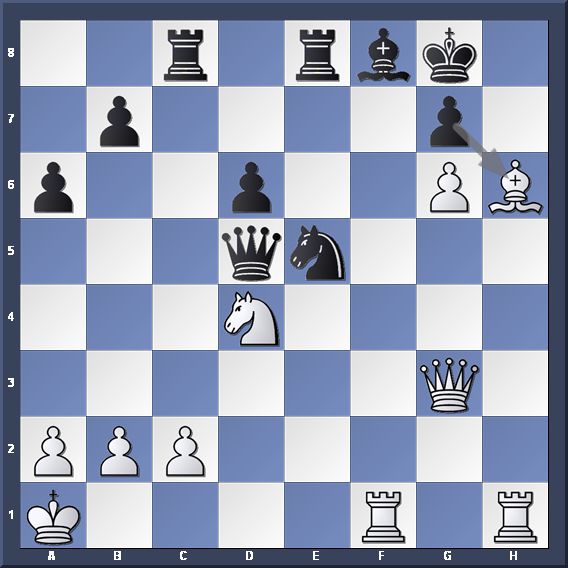
29...gxh6 (Taking the other piece 29...Qxd4 leads to typical mating pattern: 30.Be3! Qg4 31.Rh8+! Kxh8 32.Qh2+ Kg8 33.Qh7 mate.)
30.g7 Be7 (Accepting the pawn 30...Bxg7 loses after 31.Nf5 Rc7 32.Nxh6+ Kh7 33.Ng4+ [33.Nf7+ takes longer to win after 33...Qxh1.] and white wins either after 33...Kg8 34.Nf6+; or after 33...Qxh1 34.Nf6+! Kh8 [34...Bxf6 35.Rxh1+ Bh4 36.Rxh4 mates.] 35.Rxh1+ Bh6 36.Rxh6+ Rh7 37.Rxh7 mate.
The difference between the two kings is noticeable after 30...Nf7 31.gxf8Q+ Kxf8 32.Nf5 Qe5 33.Nxh6 Rc7 34.Qg6! and white wins.)
31.Rxh6 Nf7 32.Qg6! (The precise way. The combination 32.Rh8+ Nxh8 33.gxh8Q+ Kxh8 doesn't work that well because the square h1 is covered and there is no 34.Rh1 mate.)
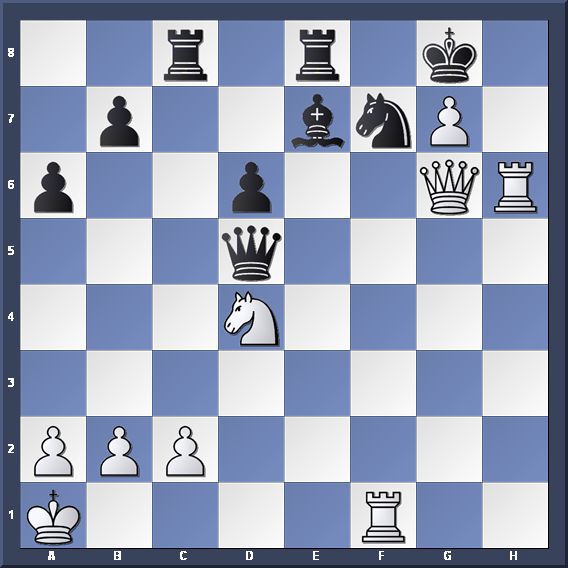
32...Nxh6 33.Qxh6 Bf6 (The last trick [34.Rxf6?? Re1+ 35.Qc1 Rxc1 mate.], but Carlsen finishes the game forcefully.) 34.Qh8+ Kf7 35.g8Q+ Rxg8 36.Qxf6+ Ke8 37.Re1+ (After 37...Kd7 38.Qe7 mates, and after 37...Qe5 38.Rxe5+ dxe5 39.Qe6+ white picks up one of the rooks.) Black resigned.
The Philippine GM Wesley So,17, leads the B-grandmaster group with a 6-2 score. His countryman and the first Asian grandmaster, Eugene Torre, always spoke highly of him, comparing his earlier development to Bobby Fischer. So became grandmaster at the age of 14 without too much high-level coaching.
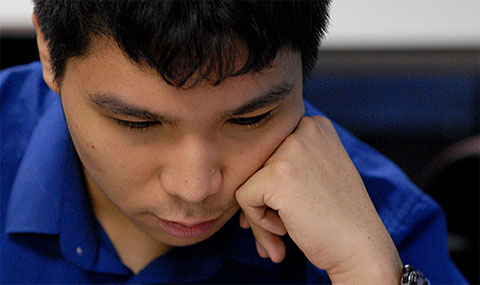
In round 7, So won an important theoretical game in the Fianchetto Grunfeld. Developed by the Czech players in the 1960s, the variation is a classic confrontation between the white pawn center and the black light pieces. Both grandmasters, Wesley So and David Navara, played it in the past and we could have expected a new twist. It came on move 13, when So uncorked a new pawn sacrifice recommended by a few chess engines.
So - Navara
Wijk aan Zee 2011
Grandmaster Group B, Round 7
1.d4 Nf6 2.c4 g6 3.Nf3 Bg7 4.g3 d5 5.cxd5 Nxd5 6.Bg2 Nb6 7.Nc3 Nc6
(Attacking the center before white castles prevents the advance of the d-pawn. The Czech grandmasters had a lion's share in developing this dynamic variation. The black pieces are holding the white pawn center in check.)
8.e3 0-0 9.0-0 Re8
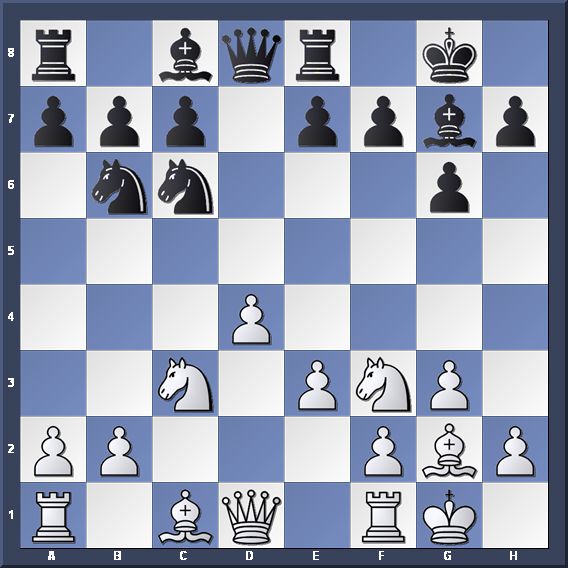
(Postponing the e7-e5 strike in the center, black plays a useful waiting move, discouraging white from developing his dark bishop on the long diagonal. The main idea is 10.b3 e5 11.d5? e4! And white is in trouble.
Kasparov gets lot of credit for using the rook move, but in fairness he was only two years old when it was first played by Vlastimil Hort during the tournament in Marianske Lazne in 1965.)
10.Re1 (The major alternative is 10.d5, hoping to grab some space. After 10.Qe2 e5 11.Nxe5 Nxe5 12.dxe5 Bxe5 13.Rd1 Qe7 14.f4 Bxc3 15.bxc3 the pawn sacrifice 15...Bf5!? 16.Bxb7 Rab8 17.Bc6 Red8, threatening a positional exchange 18...Be4, gives black a nice play on the light squares as in the game Kavalek-Hort, Marianske Lazne 1965.)
10...a5 11.Qe2
(Trying to reshuffle his heavy pieces: the queen frees the square d1 for the rook, but it allows the advance of the e-pawn.
A similar idea is 11.Qc2 e5 12.Nxe5 Nxe5 13.dxe5 Bxe5 14.e4 c6 15.f4 Bd4+ 16.Kh1 Nd5 17.Rd1 Nb4 18.Qe2 Qb6 19.a3 Nd5 20.Qc2 Nf6 21.h3 Be6 22.Na4 Qa7 23.Bd2 Rad8 24.Bc3 Nh5 25.Bxd4 Rxd4 26.Kh2 Rxa4 27.f5 Rc4 28.Qe2 Bd5 White resigned in Khismatullin -Nepomniachtchi, Moscow 2010.
Carlsen suffered a crushing defeat in the third round in Wijk aan Zee by playing 11.Qd2 against Anish Giri. The queen supported the d-pawn, but it was on the wrong spot and the game ended quickly with inexplicable blunders from white: 11...e5 12.d5 Nb4 13.e4 c6 14.a3 cxd5 15.axb4 axb4 16.Rxa8 bxc3 17.bxc3 Nxa8 18.exd5 Nb6 19.Rd1 e4 20.Ng5? e3! 21.Qb2 Qxg5 22.Bxe3 Qg4 White resigned, Carlsen-Giri, Wijk aan Zee 2011.
11...a4
(After this move, white can stick his rook on the square d1. But the problem is what can black do after 11...e5 12.Nxe5 Nxe5 13.dxe5 Bxe5 and now:
A. After 14.f4 Bxc3 15.bxc3 Bf5!? the same pawn sacrifice as in the game Kavalek-Hort still works here.
B. 14.e4!? This move gives black more fits, for example: 14...Be6 15.f4 Bxc3!? [A better alternative to 15...Bd4+ 16.Be3 Nc4 17.Bf2 with a slight edge for white.] 16.bxc3 Bd5 17.Qf2 Bc6 and in the game l'Ami-Nepomniachtchi, Wijk aan Zee 2011, round 8, white got better chances with 18.Ba3!? Na4 [Winning a pawn 18...Qd3 19.Rad1 Qxc3 is too risky after 20.Bb2.] 19.Rad1 Qf6 20.Rd4 Rad8 21.e5 Qe6 22.f5! gxf5 23.Bxc6 Qxc6 24.Qxf5 Rxd4 25.cxd4 Qe6 and instead of 26.Qg5+?, White should have played 26.Qf3!, for example 26...c6 27.Re4 Nb6 28.Rh4 Nd5 29.Qh5 h6 30.Bc1 with a decisive attack.) 12.Rd1 Be6?! (The passive 12...Bd7 was played without much success.)
13.d5!
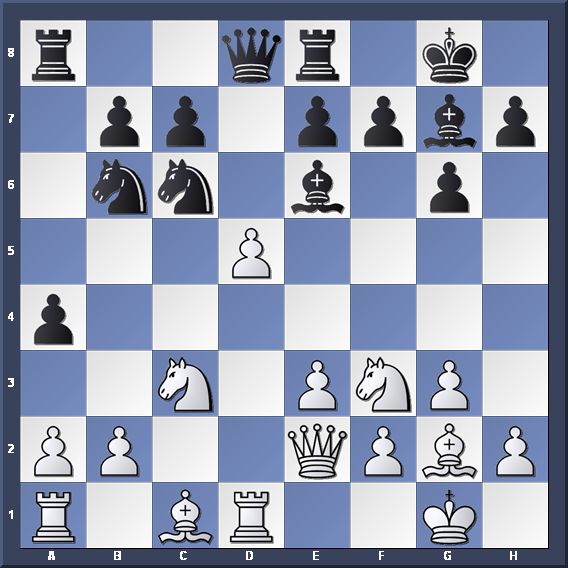
(The computers figured out the dangerous tactics along the d-file and came up with a promising pawn sacrifice. Navara already played 12...Be6 against Laznicka in the Czech Blitz Championship last December. The game continued with 13.Nd2 f5 14.Rb1 Qc8? and now white missed 15.d5! Bxc3 16.dxc6! and because of the threat 17.cxb7, white wins a piece. Laznicka later won anyway, but blunders are expected in blitz games. So as black had his own experience in this variation. It wasn't a good one. Instead of the blunder 14...Qc8?, he played 14...Bf7, but after 15.b3 axb3 16.axb3 Nd5 17.Bb2 Qd7 18.Na4 b6 19.Nf3 Na5 20.Ng5 Nxb3 21.Nxf7 Rxa4 white came up with a spectacular move 22.Nd6!
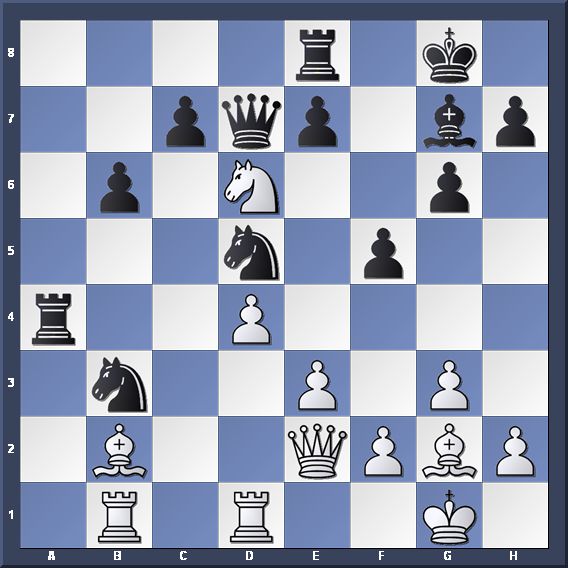
22...Qxd6 23.Qb5, hitting everything and winning material: 23...Rd8 24.Qxa4 Na5 25.Rdc1 c6 26.Ba3 Qe6 27.Bc5 Nxe3 28.Bxb6 Nxg2 29.Bxd8 f4 30.Bxa5 Ne3 31.Qxc6 and black resigned in the game Harikrishna -So, Guangzhou 2010.)
13...Nxd5 14.Nb5!
(The point! White threatens 15.e4 and because black can't escape from the pin quickly, white gets a bishop pair and shatters black's pawn structure. White can't utilize the pin immediately with 14.Nxd5 Bxd5 15.e4 since black has 15...Bc4! 16.Qc2 Nb4! winning.) 14...Qc8 15.Ng5 Rd8 16.Nxe6 fxe6 17.Rb1
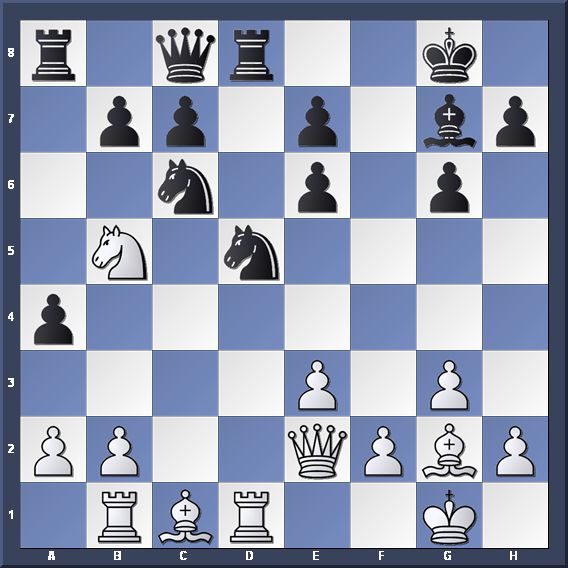
(Preparing to develop the dark bishop, white is slightly better. He has a bishop pair, no weaknesses and threatens to drive black pieces back. Black's extra pawn is not significant, it's an useless double-pawn. His other pieces are not well coordinated. Even if there is some way to hold the position, it would not be pleasant.) 17...Kh8 (Anticipating a hit from e6, Navara removes his king. The alternatives include some knight moves:
A. 17...Nb6 18.Bd2 Ne5 19.Bc3 Rxd1+ 20.Rxd1 c6 21.Bxe5 Bxe5 22.Nd4 Bxd4 23.exd4 Nd5 24.Bh3 Kf7 25.Re1 Nc7;
B. 17...Ne5 18.e4 Nb6 19.Rxd8+ Qxd8 20.Bg5;
C. Deep Rybka 4 recommends to retreat 17...Nf6 18.Bd2 Ne5 or 18...Ne8 19.f4 Nd6 and the chances are roughly equal.)
18.Bh3 (Interestingly, So refrains from the move e3-e4 that weakens the square d4.)
18...Nf6 19.Bd2 Ra6 (The machines like 19...Ne4 better, although white has some pressure after 20.Bc3 Nxc3 21.bxc3 Rxd1+ 22.Rxd1 Nd8 23.Qc4 c6 24.Nd4.)
20.Bc3
(White's bishop pair has black's position in crossfire.) 20...Rd5 21.Rxd5 Nxd5 22.Bxg7+ (Removing the defender is preferable to keeping the bishop pair with 22.Be1.) 22...Kxg7 23.Qc4 (Threatening to win a piece with 24.Qxd5. Other road to advantage is 23.Rd1 Nf6 24.e4 Rb6 25.e5.)
23...Nf6 24.Rd1! (24.Bxe6 Ne5 25.Bxc8 Nxc4 makes the defense easier for black.) 24...Kf7 25.Qf4!? (Stronger than going into a slightly better endgame after 25.Bxe6+ Qxe6 26.Qxe6+ Kxe6 27.Nxc7+ Ke5 28.Nxa6 bxa6.)
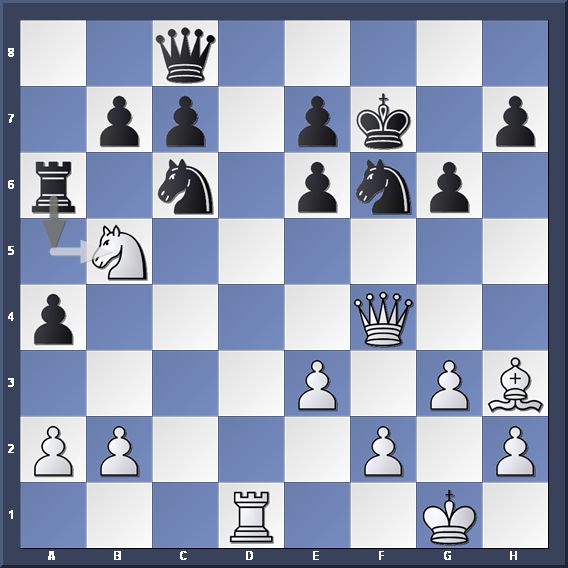
25...Rb6 (After 25...Ra5 26.Qxc7 Qxc7 27.Nxc7 white stands better.) 26.Qxa4 Ne5 27.Nd4 c5 28.Qc2! (The pin allows white to protect the b-pawn.) 28...Rd6 29.f4!?
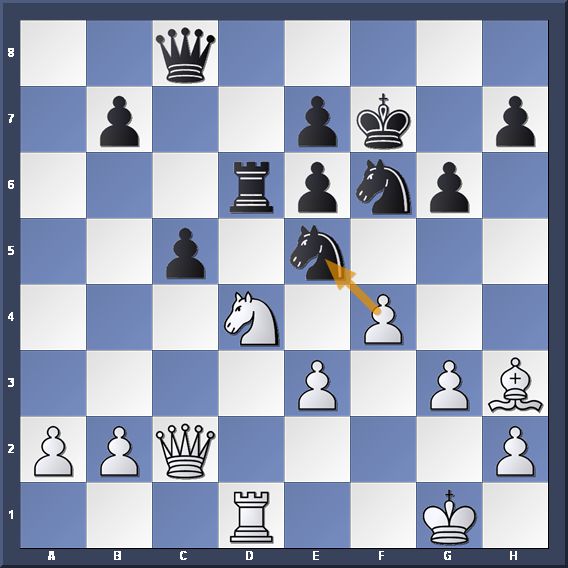
(Taking advantage of the unstable black horse.) 29...Neg4 (The knight will be vulnerable, but after 29...Ned7 30.Nxe6 white is a healthy pawn up since 30...Rxe6 31.Bxe6+ Kxe6 loses to 32.Qc4+ Kf5 33.e4+! Nxe4 (33...Kg4 34.Qe6+ Kf3 35.Rd3+ Ke2 36.Qb3 Nxe4 37.Qd1#) 34.Qd5+;
After 29...Nc6 30.Qxc5 white should win.) 30.Re1 b6 [30...Kg7 31.Nf3±] 31.Nf3 Qd7? (Stepping into a fork, black loses a piece. After 31...Rd8 32.Qb3, threatening 33.Ng5+ and 33.Qxb6, white wins a pawn.) 32.Bxg4 Nxg4 33.h3 (Winning a piece.) 33...Nxe3 (After 33...Nf6 34.Ne5+ white wins.) 34.Rxe3 Black resigned.
Photos © Frits Agterdenbos of ChessVista
No comments:
Post a Comment